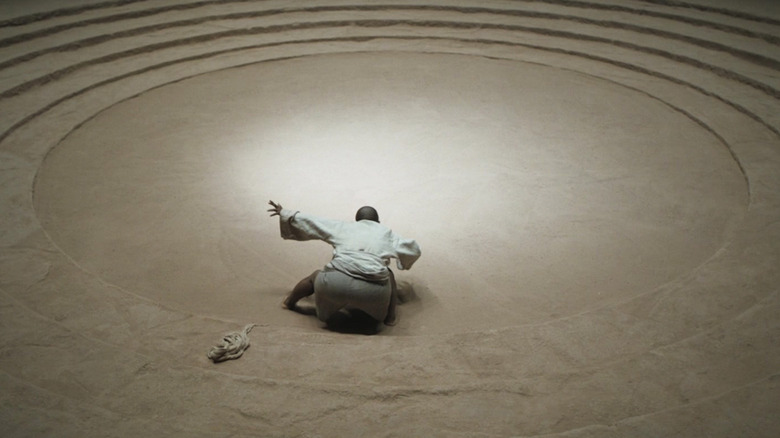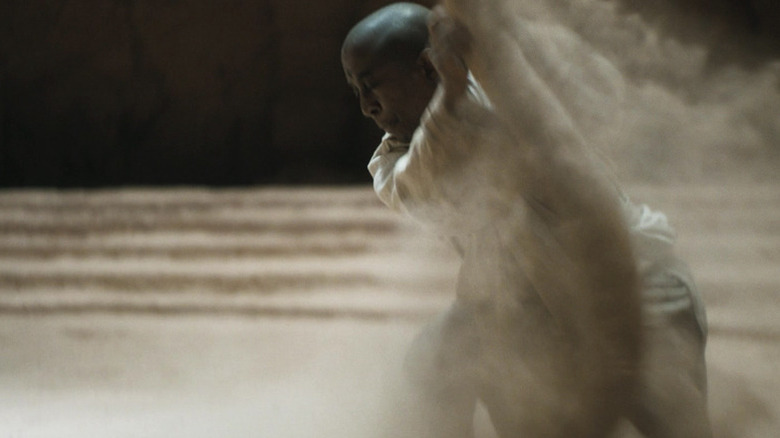Dune 2's Baby Sandworms Were Surprisingly Created With Practical Effects
We may receive a commission on purchases made from links.
Director Denis Villeneuve's "Dune" films are incredible feats of adaptation, bringing a vibrancy and modern sheen of tactility to Frank Herbert's 1965 sci-fi novel. The world-building is jaw-dropping, whether it's in the orange-tinged Harkonnen anti-gravity attack of "Dune: Part Two," or the deranged character choices of the film's villains; everything we see feels like it belongs in this universe, and the world feels so fully realized that it's easy to imagine ravenous fans spending hours taking deep dives into the films' expansive lore.
Case in point: The relatively short scene involving Lady Jessica (Rebecca Ferguson) entering the Maker's Temple and meeting the Maker Keeper (Alison Halstead), who lures a baby sandworm into her waiting arms ... only to drown it in order to extract the Water of Life from its corpse. The film tells you just enough so you can understand what's happening, but doesn't get into the same level of detail that the book does; you can read much more about how the Water of Life works in the "Dune" saga right here.
But while the movie's biggest scenes involve riding on the backs of sandworms or utilizing gigantic CG versions of them as weapons in the climactic battle, the Water of Life scene is much smaller in scale — and it actually used practical baby sandworms. In Tanya LaPointe and Stefanie Broos' book "The Art and Soul of Dune: Part Two," the authors quote Denis Villeneuve as wanting "a physical worm, like a boa, about ten feet long," and after having debates about how to achieve that, the filmmakers decided to do it practically. "Sometimes I feel that the old tricks are the best," Villeneuve said. "In a perfect world, we'll use a wire to wrap it around the actor."
But the biggest challenge wasn't creating the worm itself, but making it look like the worm was physically slithering through the sand.
How Dune: Part Two made a convincing and practical baby sandworm
In "The Art and Soul of Dune: Part Two," Gerd Nefzer, the special effects supervisor of the movie, explained that this little baby sandworm was the biggest challenge of the entire film for the special effects team. It took six weeks to develop and test before they got it right.
"We made a worm out of eight balls connected with a chain and skinned in a special spiral tube in the sand," he said, also acknowledging that "very often, it's the small stuff we have to work most on." Villeneuve's directive was that the baby sandworm needed to "jump like a snake, nightmarish and fast," and to achieve this goal, Nefzer and his team ended up burying two tracks under the sand — one for the circular motion the worm makes, and another that goes straight for the Maker Keeper when it leaps out of the sand. According to the book, Iván Pohárnok, who made the worm props, was one of five puppeteers controlling various parts of the baby sandworm puppet to make its motion appear natural and seamless on set. the baby worm along with four puppeteers controlling various parts of the puppet. The results are impressive and surprisingly poignant, given the respect the Fremen characters have for this creature in their culture.
Just for comparison's sake, take a look at how David Lynch's "Dune" handled similar subject matter in the 1980s:

